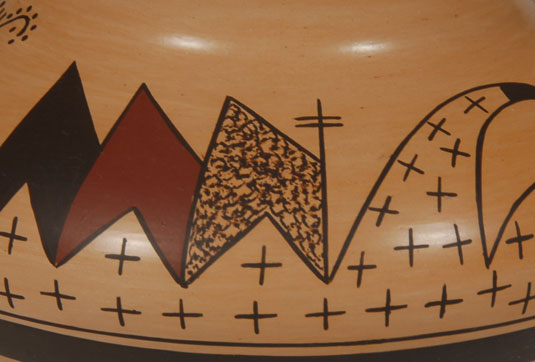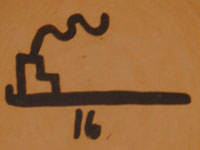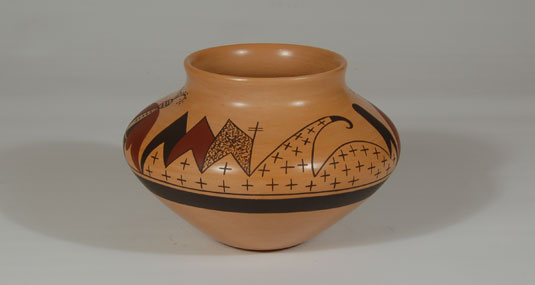Mark Tahbo Jar Inspired by Work of Grace Chapella [SOLD]
+ Add to my watchlist Forward to Friend
- Category: Modern
- Origin: Hopi Pueblo, Hopituh Shi-nu-mu
- Medium: clay, pigment
- Size: 3-3/4” height x 5-3/4” diameter
- Item # 25912 SOLD

Mark Tahbo’s great-grandmother was Grace Chapella and his grandmother was Alma Chapella Tahbo. Mark remembers Grace because she encouraged him to work with clay when he was a youngster. Mark was around 22 years old when Grace passed away at the age of 107 years. Mark reminisced about Grace when he brought us this jar. He said that when she was about 104 years she made a jar about the size of this one he brought us and it was the largest jar she had made in years and years, so her daughter, Alma hid it from Grace so she would not break it or ruin it by painting the design. Grace searched and searched for the jar and finally found it hidden behind a door in a stove. She took it out and held it while sitting in a chair and fell asleep with it in her lap. Of course, it fell to the floor and broke in many pieces. She awoke and said that Alma is going to be very angry at her, which, of course, was the case.
This small jar by Mark Tahbo is based on a style of design used by Grace. The butterfly or moth is almost a hallmark of her design. She used it many times. The faces of the butterflies, according to Mark, identify the gender. The face divided into four quadrants is a male and the one with three vertical and three horizontal lines that cross is a female.
The three triangular items painted black, red and stippled represent the three Hopi Mesas. The star-like elements represent corn fields and the area in which they are enclosed represents rain. The line with a pair of crossing lines is a dragonfly, a water creature important for the crops.
Mark enjoys working with a variety of clays. The artists at Hopi have a choice of clay from the Jeddito region, just behind the village of Polacca, or Sikyatki clay from the prehistoric ruins so important to the career of Nampeyo. In this jar, Mark selected clay from Jeddito which fires to a beautiful orange blush. It has even been speculated that the vessels of gold that the Spaniards were looking for could easily have been the beautiful gold-color prehistoric Jeddito wares. [Hargrave. American Southwest Virtual Museum, Northern Arizona University.]
 The source of the burgundy-color is a rock Mark found. He grinds it up into a powder and uses it as a paint. The other red seen on most Hopi pottery is from a clay source.
The source of the burgundy-color is a rock Mark found. He grinds it up into a powder and uses it as a paint. The other red seen on most Hopi pottery is from a clay source.
Condition: new
Provenance: from the artist
Recommended Reading: Hopi-Tewa Pottery: 500 Artist Biographies by Gregory and Angie Schaaf

- Category: Modern
- Origin: Hopi Pueblo, Hopituh Shi-nu-mu
- Medium: clay, pigment
- Size: 3-3/4” height x 5-3/4” diameter
- Item # 25912 SOLD



